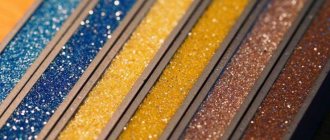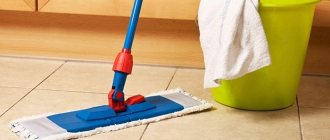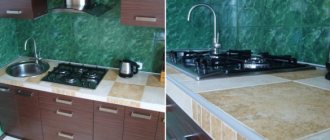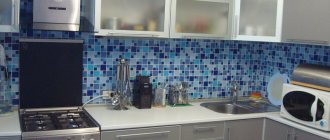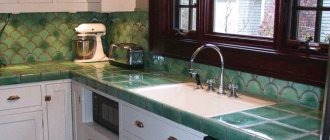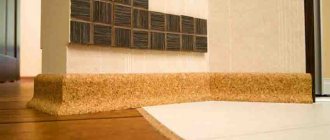To grout tile joints, in most cases a mixture based on cement is used. But it has a number of significant disadvantages, one of them is low moisture resistance and, as a consequence, the need for measures to increase resistance to moisture. That's why the creation of epoxy grout for tiles has solved many problems in interior decoration. True, experienced craftsmen have an ambiguous attitude towards the material, but each argues this in their own way.
Characteristics of epoxy grout
For many, when they hear about “epoxy,” they think of a well-known one-component composition used as an adhesive. However, a slightly different material, a special grouting paste, is used to grout tile joints. Its main components are: epoxy resin and a special hardener. Various fillers can also be added to enhance the decorative properties of the product.
What's good about this grout? Firstly, it is distinguished by maximum resistance to moisture. Water that falls on this surface is not absorbed at all, it simply rolls off. Moreover, the grout is not susceptible to all kinds of chemicals used in everyday life.
Choosing the appropriate composition
First of all, you need to pay attention to the type of main components that the epoxy-based grout contains. The composition of such materials may include cement, various additives that increase elasticity and improve other properties. The cost of grouting will depend on this. Another factor is brand. Common options:
- Mapei Kerapoxy Design;
- Litokol Litochrom Starlike;
- Diamond.
The cost varies between 900-1100 rubles. per 1 kg of substance. The grout does not have to be updated regularly, since it does not lose its properties throughout its entire service life. By comparison, the cement version quickly deteriorates. This substance loses strength, over time it begins to absorb moisture more strongly, and cracks form on the surface.
You also need to calculate the volume of grout required to finish the wall or floor. In this case, information from the manufacturer is taken into account. In most cases, the label indicates how much substance is consumed per 1 m². Based on this, you need to calculate the total amount of grout per area to be treated. If you immediately purchase the required amount of material, you can reduce the surface finishing time.
Scope of application of the composition
Epoxy grout is successfully used for both interior decoration and exterior work. It is indeed used for any cladding elements, not excluding even products with a glossy finish.
Grout based on epoxy resin can be used in the following cases:
- when you need to seal tile joints in the dining room, kitchen, hallway, bathroom or shower room;
- as a mixture for sealing the joints of tiles in a bathhouse, sauna or pool bowl;
- for reliable strengthening of tile joints on a terrace or open area;
- with joint widths ranging from 1 to 15 mm;
- technology allows you to apply this mixture even on a base equipped with a “warm floor” design.
Advice! If we take it more broadly, there are practically no restrictions in application. It is only necessary to make a small reservation that this grout paste is not entirely appropriate for lining stoves and fireplaces.
Pros and cons of using epoxy grout
Speaking about the wide scope of application of this composition, we can come to the conclusion that it has only advantages. Undoubtedly, there are many positive aspects associated with the use of epoxy grout:
- Durability. The duration of the operational period is measured in tens of years. Some manufacturers express confidence that their products will last more than 50 years.
- Increased strength. For simplicity, we briefly note that such a composition, when hardened, forms a very strong layer that is difficult to dismantle.
- Practically does not fade. The shades of the grout are able to maintain their brightness and saturation, even when exposed to direct sunlight for a long time.
- Not susceptible to deformation due to sudden temperature changes.
- Dries without shrinkage or cracking.
- Does not interact with aggressive chemicals. Of course, if etching is carried out intentionally, the material will gradually deteriorate.
- Does not contain elements harmful to human health. As a result, the solution can be used in any home.
However, one cannot fail to take into account the fact that in addition to the positive qualities of the composition, there are some disadvantages in its use:
- The resin hardens quite quickly, which limits the time of work and correction. Therefore, all actions must be performed clearly and correctly. Setting time is about 40 minutes.
- Only a special tool is suitable for the work, which you need to learn how to use.
- The price of epoxy mixture is higher than other types of material. Because of this, finishing large areas can have a significant impact on the overall cost of the renovation.
- If it is necessary to replace the grout, you will have to dismantle it along with the tiles. Naturally, there is a special chemical method, but it is very harmful and labor-intensive.
It follows from this that before choosing this composition, you need to weigh all its positive and negative sides.
Top 5 tile grout manufacturers
There are now many grout manufacturers on the market for various purposes. It is easy to buy both domestic and imported mixtures. In 2020, the following manufacturers and models are popular:
Ceresit
A well-known company in construction and repair circles, part of the Henkel company. Its products are sold in most countries of the world due to their quality and reasonable price. Offers various types of fugues, most often cement-based, but there are latex and epoxy models.
Ceresit CE 40 Aquastatic
A mixture of cement with mineral and organic additives for filling joints of ceramics, glass, stone for horizontal and vertical surfaces. The Aquastatic effect will prevent water penetration, Silica Active will prevent the growth of fungus. Suitable for dry and wet rooms, outdoor work. Seam width – up to 10 mm. Sold in packages of 2 and 5 kg. Has a wide palette of colors. Price for 2 kg – about 300 rubles.
Ceresit CE 40 Aquastatic
Ceresit CE 33 Super
A similar mixture without the moisture-proof component. Suitable for narrow seams, but will tolerate direct water and high humidity worse. The range of colors is wide. There are packages of 2 and 5 kg. Price – from 150 rub. for 2 kg.
Ceresit CE 33 Super
Ceresit CS 25
Ready-made silicone grout, which the manufacturer recommends to use for sealing seams in corners and joints. Gives elasticity, can be used for seams from 5 to 30 mm wide. Moisture resistant and contains antifungal impregnation. Price for 280 ml – from 300 rubles. This amount can be enough for an area of up to 10 m2.
Ceresit CS 25
Mapei
Italian manufacturer of building mixtures. The name is an abbreviation “Materiali Ausiliari Per l'Edilizia e l'Industria”, which translated from Italian into Russian would sound like “auxiliary materials for construction and industry”.
Mapei Ultracolor Plus
Cement mixture for joints with a width of 2 to 20 mm. Suitable for outdoor work: it tolerates low and high temperatures well, differences between them, and has good moisture resistance. 2 kg of any color will cost from 200-250 rubles.
Mapei Ultracolor Plus
Mapei Kerapoxy
Ready-made epoxy mixture for various purposes. The manufacturer recommends use at temperatures from -20 to +100°C. It withstands moisture and chemically active substances well. The estimated consumption will be 0.3-2.4 kg/m2. A 5 kg package will cost from 2300 rubles.
Mapei Kerapoxy
Litokol
An Italian company that started out by creating and selling adhesives for laying tiles. Now popular in Europe, CIS countries and China.
Litokol Litochrom Starlike
Epoxy grout for joints 1-15 mm. Wide range of colors, resistance to moisture, chemical compounds, temperature changes. Excess material on the tiles can be removed or corrected within an hour after application. Ideal for small tiles, mosaics and decorative masonry. Wide variety of colors. The price corresponds to the declared quality: for 2.5 kg from 2100 rubles.
Litokol Litochrom Starlike
Litokol Litochrom Luxury 1-6
Cement one-component mixture. Requires preliminary dilution with water (300 ml per 1 kg of dry composition). Suitable for narrow, small slabs: 1-6 in the name - permissible application width in mm. Includes an antifungal agent. Withstands down to -50°C and direct exposure to water. 2 kg – about 300 rubles.
Litokol Litochrom Luxury 1-6
Kerakoll
Another Italian concern for the production of dry and liquid construction mixtures. It has firmly occupied the shelves of Russian stores. Concerned about the protection of nature and the environment, from the production stage of the product to its entire service life.
Kerakoll Fugalite Eco
A general purpose epoxy ready-mix grout, well suited for very damp areas. The two-component composition will prevent the penetration of water and fungus, and will also make it impossible for mold to grow on the grout surface. Suitable for both small slabs and wide joints: recommended width is from 1 to 20 mm. Operates at temperatures from -40 to +110°C. The price for a bucket of 3 kg starts from 4,000 rubles.
Kerakoll Fugalite Eco
Kerakoll Fugabella Eco Porcelana 0-8
Mineral grout for joints up to 8 mm. It is sold in dry form, so for “activation” it is diluted in water in a ratio of 1:4 (250 ml of water per 1 kg of mixture). Tolerates temperature, humidity, prevents mold from growing. 2 kg bag - from 600 rubles.
Kerakoll Fugabella Eco Porcelana 0-8
KIILTO
Finnish company producing building materials for 100 years. Known for the quality and reliability of its products.
KIILTO Saumalaasti
Cement dry mixture for narrow joints (up to 6 mm). It remains plastic for a long time (up to 3 hours) and completely dries within 24 hours. It will not withstand chemicals, but will withstand humid air and water without problems. The only mixture of the company that is officially sold in Russia. 1 kg sells from 200 rubles. Packages of 3, 10 and 20 kg are also available.
KIILTO Saumalaasti
How to choose grout color
Without exaggeration, epoxy grout can be called reliable protection. A very important issue remains the choice of its color. The content of pigment additives in the grout allows you to enjoy a rich color palette. Of course, from a wide variety you can choose the most suitable shade, but often this is not so easy.
Thanks to modern technologies, it has become possible to create almost completely transparent materials. If you want to add sophistication to the surface, there are special components that, with their shine, create the illusion of tiny stars.
To obtain a high-quality harmonious coating, basic recommendations were developed. Compliance with them will help to veil some of the imperfections of the room and draw attention to its advantages.
- Light-colored tiles are combined with pastel-colored grout to ensure surface unity and compositional integrity.
- To obtain the opposite effect, use dark tones. In this way, it will be possible to highlight individual details of the composition by dividing the surface into parts.
- When using plain tiles, the grout paste should be selected based on the main color scheme of the interior.
- The versatility of white is undeniable. It is appropriate to turn to it for sealing seams in any type of interior. It is not recommended to use it in corridors and hallways where traffic is high.
Of course, everyone can be guided by their imagination. In any case, the main goal is to get a room that brings joy to its owner.
The best tile grout
The most popular grouts in 2020 and 2020 are from the manufacturers Ceresit (inexpensive segment) and Mapei (slightly more expensive grout).
Other popular grout manufacturers (by degree of popularity):
- Vetonit Deco;
- Litokol;
- Kiilto;
- Isomat.
View this post on Instagram
A little more about mosaic grouting. . We used epoxy two-component grout from #Kerakoll here. It’s very pleasant to work with her, she even has a special, pleasant smell☺️ . Fine-grained, soft, mobile. Mapei and Litokol are slightly more viscous, most likely due to the larger grain. . The second component is liquid, in an opaque bottle. That is, it is not clear how much of it is there initially and how much of it remains. Therefore, work only through scales. The proportion of components is approximately 1:16. In this regard, Mapei is certainly beyond competition - you can work without weights and everything is in sight. . . Mosaic #atlasconcorde. Object #ib_odintsovo. . . . #SystemDemina #chokd #laying_tiles_in_details #repair #finishing #laying tiles #tiled cladding #Italian tiles #bathroom #bathroom #bathroom #mosaic #laying mosaics #grout #grout #grout #epoxy grout #grout #grouting
Posted by Dmitriy Drozdov (@instabur.pro) May 6, 2020 at 5:11 PDT
For those who have not yet decided on the type and color of grout, we suggest that you familiarize yourself with the 4-step guide.
How to work with the solution correctly
Before starting activities with two-component grouting, it is necessary to prepare the tool. To carry out the work comfortably you will need:
- wide rubber spatula;
- spatula forming seams;
- a drill and a nozzle specially designed for mixing the solution;
- cellulose sponge for construction work, which retains its properties for a long time;
- grater with cellulose attachment;
- latex gloves;
- goggles to prevent mixture from getting into your eyes when working at heights.
Advice! A cellulose sponge can also be replaced by ordinary foam rubber, but you will need much more of it.
You will also probably need a scraper to remove dried compound from the tiles and a soft cloth.
Be sure to follow safety precautions! Although toxic substances are not released from the finished coating, contact of the liquid mixture with the mucous membrane of the mouth, eyes, as well as inhalation of its vapors is highly likely to provoke irritation and a more serious reaction.
Preparation of the solution
As we mentioned earlier, epoxy mosaic grout is sold in two parts, each in separate packages. The main component is epoxy resin, which includes additives in the form of quartz sand, dyes, and plasticizers. The second component, which plays a secondary role, is the hardener. You need to mix a small amount of product. Excess is not needed, as it will lead to the material losing its qualities. And this situation cannot be corrected.
So, you need to pour both components into one container and mix thoroughly. In order for the mixture to “reach”, it must be left for 5 minutes. After this, mix again.
Advice! Mixing should be done with a drill smoothly at low speeds. Otherwise, air bubbles will form and the seam will become porous when dry.
The order of filling the seams
Epoxy grout should be properly applied to slab joints as follows:
- Carry out thorough cleaning of the gaps from the slab adhesive. The result should be clean crevice spaces free of dirt and dust.
- Clear spaces from plastic crosses or tile leveling system elements.
- It is strictly forbidden to wet the surface. The base must be dry. Otherwise, applying mastic will be very difficult.
- Apply the mixture with a hard rubber-coated spatula. Distribute it evenly along the seams of the entire area.
- Form decorative joints on the treated area.
- To simplify the procedure, it is recommended to cover the edges of the tiles with masking tape.
Advice! During work, you must carefully monitor the appearance of excess and remove it immediately. If you leave pieces of the mixture for more than 5 minutes, you will need to force them off.
After all the seams have been uniformly filled in one area, the mixture must be wiped off with a sponge dipped in warm water. The resulting stains can be left and subsequently removed with a special product, which is purchased in addition to the composition.
The grout will finally harden in five days. The surface will acquire the desired qualities and resistance to various influences.
Application technology
You can begin sealing the seams after the tile adhesive has completely dried, no earlier than 24 hours after completion of the tiling work.
Epoxy grout can only be applied to dry seams that are free of dust and glue.
Important! It is better to use epoxy grout when the thickness of the seams between the tiles is at least two to three millimeters, due to the thick and inelastic structure of the mixture, which is difficult to fill thin seams.
To get a high-quality and reliable result, we carry out the work in the following order:
- We take a small amount of grout onto a rubber spatula and press it into the seam. When using a special bag with a tip, squeeze the mixture directly between the tiles, then level it with a spatula or rubber float.
Figure 6. Sealing joints with epoxy grout.
- Using a wet sponge, we blur the seams, forming an even and smooth seam. In this case, joints that are not filled with grout should not be allowed to become wet.
- Carefully wipe the surface of the tile and grout with a damp cloth.
- We begin to seal the seams on the second grip, performing sequentially the same actions as on the first.
- 40-45 minutes after forming the seam, spray the surface with water from a spray bottle and finally smooth it with a finger in a rubber glove or a sponge. This manipulation will allow you to get a perfectly smooth seam.
Figure 7. Removing excess epoxy grout.
Epoxy grout should gain strength within two to three days. This is especially important for floor joints. Therefore, you should not move on the tile until the grout has completely dried.
Try to keep the epoxy grout on the tile as little as possible. It must be removed without waiting for it to dry.
Any build-up on tiles can be removed by dampening the surface of the tiles with epoxy grout cleaner. First dilute the wash with water according to the instructions.
Figure 8. Epoxy grout remover.
After the solution is absorbed, wash off the film formed on the tile.
Important! The grout's setting time is less than forty minutes, so it must be applied quickly and accurately. In the absence of experience and relevant skills, it is better to entrust these works to professionals.
Possible errors
It happens that inexperienced craftsmen, when preparing the grout mixture, do not comply with the proportions specified in the instructions. This leads to the loss of valuable qualities by the material.
Often, careless craftsmen, when working with epoxy composition, use the same tools as for cement grout. Of course, this saves money, but the result obtained does not justify the savings. Specific material requires the use of special fixtures and tools.
If the work is carried out correctly, in compliance with the technology, the result will cause only positive emotions and favorable consequences for both the master and the customer.
The mechanism of operation of tile grout
Regardless of the manufacturer, composition, presence or absence of additional additives, the essence remains the same: the mixture fills the gaps between adjacent blocks. In this way, you can achieve several goals at once:
- make it impossible for moisture and dirt to get into the tile seams;
- prevent mold growth (when using appropriate grout);
- strengthen the masonry;
- improve appearance;
- simplify surface cleaning.
In order to achieve all goals, correct application of the fugue is important. There are differences in application techniques depending on the type, composition, and manufacturer.



